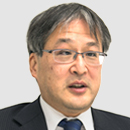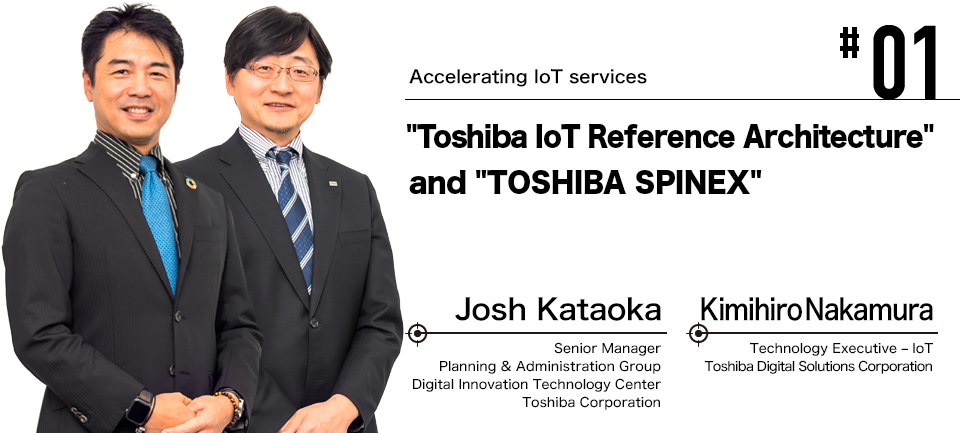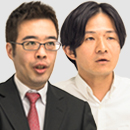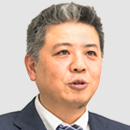The new industrial revolution driven by advanced digital technologies such as IoT and AI is not a short-lived
movement, but a steady tide that will fundamentally transform social and industrial structures. Japanese
governments is advancing policies such as Society 5.0 and Connected Industries. Cyber-Physical Systems (CPS)
that fuses cyberspace (virtual space) and physical space (real world) technologies at an advanced level is key
to realize those new world. CPS is believed to realize human-centric societies where both economic development
and solution to a social challenge go together.
Toshiba has declared its intent to become one of the world's leading CPS technology companies by 2030 in the
previously published business strategy, "Toshiba Next Plan." Toshiba has started to provide TOSHIBA SPINEX,
industrial IoT (IIoT) services that fuse physical technologies developed through long history of manufacturing
business with cyber technologies that are proving the effectiveness in a wide range of business fields.
This article introduces the roles of Toshiba IoT Reference Architecture, the common framework that accelerates
the deployment of IIoT services, and also introduces an overview of TOSHIBA SPINEX, IIoT services compliant
with the common framework to make use of Toshiba's business experiences and technological strength.
Digital capitalism towards data economy plays important roles.
In recent years, the source of economic value has been rapidly shifting from "physical things" to "data"
backed by the remarkable evolution of new technologies such as IoT and AI technologies. The conventional
approach where industrial products are made from resources and services are provided to maintain the functions
and performance of those products is rather obsolete. Instead, the new approach where data created by people
and products is used to improve functions and services, and to create new functions, services, and products is
emerging.
The dawn of "Data Economy" where economic value is created from data has just begun.
Cyber-Physical Systems (CPS) is the key of this new era. It is the mechanism where data created in physical spaces (the real world) is analyzed in cyberspace (virtual space) and transformed into information and knowledge. Those information and knowledge are in turn fed back into the real world to create new value. CPS has potential to produce tremendous changes in social and industrial structures through widespread use in various fields. Therefore, countries and companies all over the world are increasingly moving toward applying CPS as the platform from which they will drive future industrial innovation.
Click here to move to the top of this page.
Open technology platform that leverage the features of CPS is essential
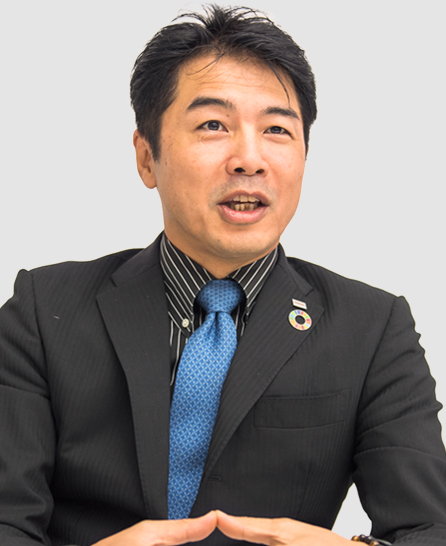
Toshiba was quick to predict these massive global changes. We have declared our intent to become one of the world's leading CPS technology companies by 2030 in previously published business strategy, or "Toshiba Next Plan." We fuse the physical technologies developed through long and diverse experience in the industrial field with cyber technologies like AI technologies such as image analysis and speech and language recognition at an advanced level. We are striving to be a leader of social and industrial transformation by creating new value for customers and driving digital transformation by bringing together our know-how, based on massive amounts of data and superb field experience.
CPS defines the following three data sources. The Internet of Things (IoT) gathers data from devices and equipment. The Internet of People (IoP) gathers data related to people, such as knowledge and behavior. The Internet of Service (IoS) gathers data through service and system operation. CPS collects data from these three data sources and stores and analyzes in cyberspace, and feeds back the results into the real world for use. One of the characteristics of CPS is this feedback loop of mutual coordination between the cyber and physical worlds. In addition, CPS has the characteristics of Systems of Systems (SoS) that multiple systems are bundled and interconnected. Moreover, CPS also involves humans in the system and reflect their intent (Fig. 1).
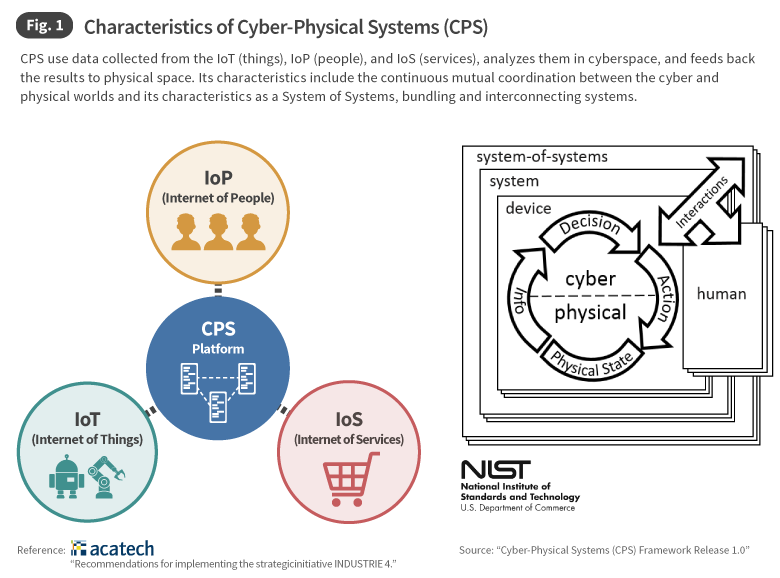
To be a CPS technology company that customers want, open technology platforms that accept technologies other than in-house technologies as well as services from other industries are inevitable as well as to leverage those CPS characteristics. The architecture of these technology platforms must uniformly apply to control systems, which can be considered as traditional CPS, and IoT services, the latest form of CPS that includes the SoS concept.
Therefore, we have worked to formulate the Toshiba IoT Reference Architecture (TIRA, hereafter) as a common framework for supporting the development and operation of industrial IoT (IIoT) services.
Click here to move to the top of this page.
Deploying IIoT services using a lunchbox-like common framework
TIRA is the platform that supports Toshiba's IIoT services. It also realizes an ecosystem where various players participate (Fig. 2).
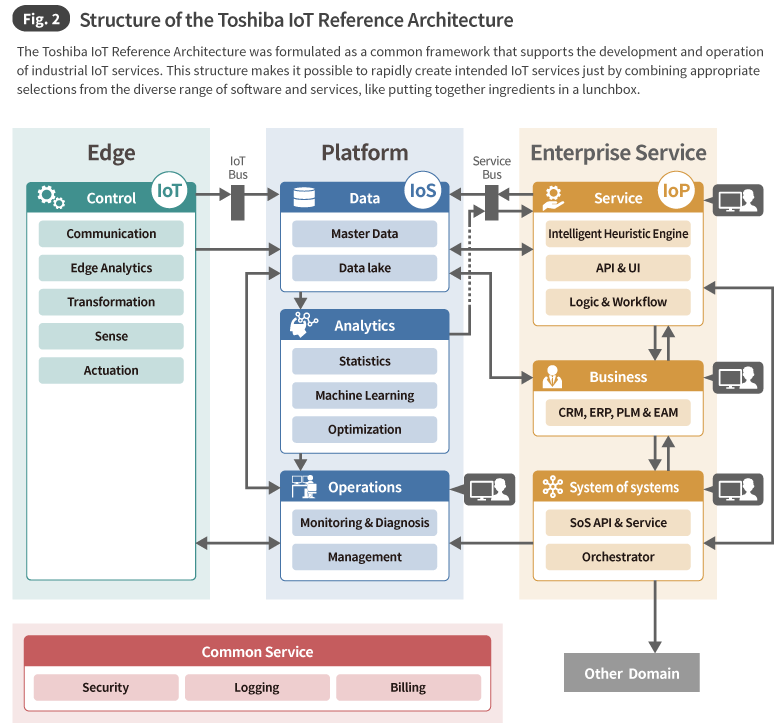
The concept and the role of TIRA is explained using a Japanese lunchbox analogy.
Japanese lunchboxes have different compartments for rice, entrees, and sides. You can create a wide variety of
lunches depending on the kind of foods, recipes and seasoning and arrangement with a balance of flavors. TIRA
was defined to provide this type of flexible functionality. It is composed of three layers -- Edge
(IoT/things), Platform (IoS/services), and Enterprise Service (IoP/people) -- connected by interfaces that
link hardware and data (IoT Busses) and interfaces that mutually link other systems and services (Service
Busses). TIRA consists of seven components based on Toshiba's expertise in the physical and cyber fields. The
interfaces also use an open architecture based on the release of APIs* to enable the interfaces to be mutually
connected to hardware other than Toshiba products and services offered by other companies.
This structure makes it possible to rapidly create intended IIoT services just by combining appropriate
selections from the diverse range of software and services, like putting together ingredients in a lunchbox.
* API: Application Programming Interface
One of the TIRA's greatest features is data-centric design that allows us to retrieve and to utilize required data promptly. We took into consideration the results of research performed around the world and included CPS features in the platform while developing TIRA. Now, TIRA's has successfully reflected in the formulation of IIRA*, a reference architecture defined by IIC**, a global industry association. These activities have further encouraged players other than Toshiba to participate in TIRA, accelerating the global development of IIoT services through open innovation that supports SoS.
* IIRA: Industrial Internet Reference Architecture
** IIC: Industrial Internet
Consortium
Click here to move to the top of this page.
From verification to implementation
The TOSHIBA SPINEX IIoT service continues to expand and advance
Toshiba has been developing various IIoT service PoCs so far. Now it is the time to step forward to implementation. This is the challenge of rolling out numerous TIRA-compliant IIoT services that are secure and offer stable quality, quickly and at low cost.
These efforts are thoroughly improving development productivity by identifying the elemental technologies that can be broadly used in diverse business fields, and by reusing those elemental technologies as components such as software and APIs. We believe that these activities are extremely effective in rapidly providing new IIoT services together with partners around the world, with the aim of accelerating business with CPS as its core.
IIoT service implementation has already made great progress in the fields of social infrastructure, energy, manufacturing, and logistics. In fiscal year 2019, we plan to provide 12 categories of services (Fig. 3). These services are being successively released under the TOSHIBA SPINEX brand of TIRA-compliant IIoT services.
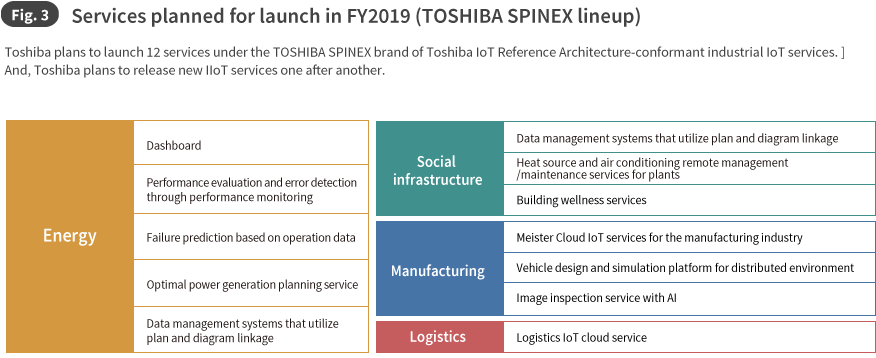
The first of those, the TOSHIBA SPINEX for Manufacturing "Meister Cloud Series," was launched on November 1, 2019. The Meister Cloud Series can quickly digitalize manufacturing industry value chains. It offers integrated data models (digital twins) that rapidly associate IoT data and operation data in areas from manufacturing to O&M*, as well as services which combine applications and APIs for factories, plants, and device manufacturers. It has rapidly attracted a great deal of attention due to its cross-supply chain traceability and its services for sharing data between factories, plants, and device manufacturers.
* O&M: Operation & Maintenance
* The Meister Cloud Series is introduced in
detail in #04.
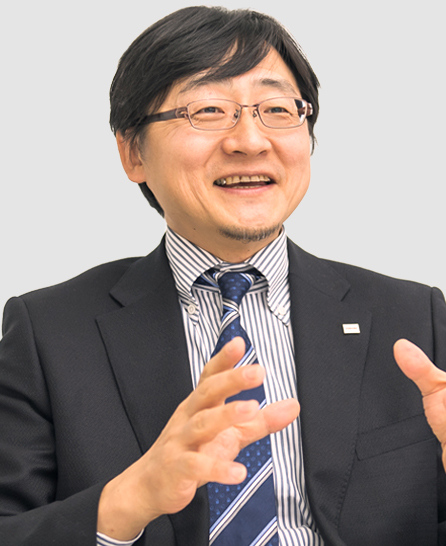
In the energy field, we have brought together Toshiba's expertise and know-how regarding plant operation and maintenance. They are combined with the advancing IoT technologies and providing Energy System IoT Solutions that aim to optimize energy plant operation and maintenance.
* Energy System IoT Solutions are introduced in detail in #03.
Furthermore, we are developing IIoT services in the social infrastructure field including heat source units management, railways O&M, and buildings management systems. It is essential for factories and plants to optimize the operation of air conditioning and industrial heat source units to reduce energy cost. We will provide services to manage the energy saving in such large spaces. As for railway systems, we will deliver services for remotely monitoring electrical components in trains to assess the operating status of equipment and optimize maintenance. As for building management systems, Toshiba’s cutting-edge AI technology digitalizes the movement of people from data collected through cameras and sensors installed in the buildings. These digitalized data together with other data from equipment such as elevators and lightings enable services for people who uses the buildings.
Toshiba will expand the TOSHIBA SPINEX lineup continuously.
We are now delivering brand-new value to our customers through brand-new business style based on TIRA-based TOSHIBA SPINEX IIoT services after the publication of Toshiba Next Plan and continuous CPS initiatives.
Now is the time for Toshiba to evolve into a genuine CPS technology company. We will continue to challenge for solving business and social issues through deployment numerous IIoT services including co-created with customers and partners by achieving widespread industry penetration with Toshiba IoT Reference Architecture.
Toshiba's approach and Toshiba's CPS technologies toward digital era, will bring brighter future to customers, society and people.
* The corporate names, organization names, job titles and other names and titles appearing in this article are those as of February 2020.
